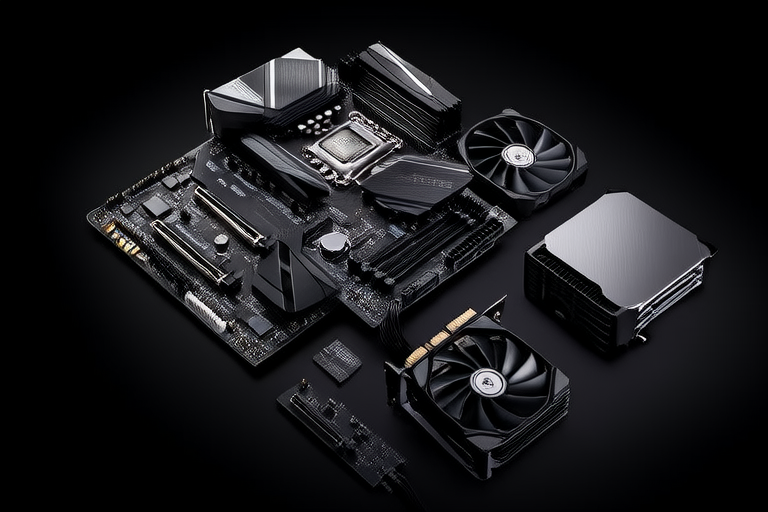“`html
Unpacking the Latest Innovations in Computer Hardware
Introduction
The rapid pace of technological advancement has transformed the computing landscape over the past few decades. At the heart of this transformation lies the relentless pursuit of innovation in computer hardware. From processors that push the boundaries of computational speed to storage solutions that offer unprecedented data access, each development plays a crucial role in enhancing performance, energy efficiency, and user experience.
This article delves into the latest advancements in key areas of computer hardware, including processors, memory, storage, graphics cards, cooling solutions, and peripheral technologies. By exploring these innovations, we aim to provide a comprehensive overview of how they impact current systems and set the stage for future trends.
Processors (CPUs)
The central processing unit (CPU) remains one of the most critical components in any computing device. Recent advancements in CPU architecture have focused on multi-core processing, hyper-threading, and new manufacturing processes. These improvements not only boost performance but also enhance power efficiency.
Multi-core processing allows CPUs to handle multiple tasks simultaneously, significantly improving multitasking capabilities. Hyper-threading further optimizes performance by enabling each core to handle two threads at once. Additionally, new manufacturing processes, such as the transition from 14nm to 7nm and beyond, reduce power consumption while increasing clock speeds.
These advancements have been reflected in impressive performance benchmarks, with CPUs now capable of executing complex calculations and running demanding applications more efficiently than ever before. This improved efficiency is particularly beneficial for power-sensitive devices like laptops and mobile devices.
Memory (RAM)
Random Access Memory (RAM) plays a vital role in determining a system’s ability to handle multiple tasks simultaneously. The evolution of RAM technologies, particularly the introduction of DDR5 and LPDDR5, has brought significant enhancements in performance and capacity.
DDR5 offers higher bandwidth and lower power consumption compared to its predecessor, DDR4. This translates to faster data transfer rates and better support for high-performance workloads, such as video editing and virtualization. LPDDR5, designed specifically for mobile devices, brings similar benefits to portable computing, ensuring smoother multitasking and extended battery life.
With these advancements, users can expect enhanced system responsiveness and improved multitasking capabilities, making it easier to switch between applications without experiencing lag or slowdowns.
Storage Solutions
Advancements in storage technology have revolutionized the way data is accessed and managed. The latest developments include Non-Volatile Memory Express (NVMe) SSDs, PCIe Gen 4/5 interfaces, and emerging formats like Zone Namespace (ZNS) drives.
NVMe SSDs provide significantly faster read/write speeds compared to traditional hard disk drives (HDDs) or even SATA SSDs. PCIe Gen 4/5 further accelerates data transfer rates, ensuring rapid boot times and efficient data handling. ZNS drives optimize storage management by grouping data into zones, reducing write amplification and extending drive lifespan.
These advancements have a profound impact on overall system responsiveness, allowing users to load applications and access files almost instantaneously. They also facilitate more efficient data handling, benefiting professionals who rely on large datasets for their work.
Graphics Cards (GPUs)
Graphics Processing Units (GPUs) have evolved far beyond their original role in rendering visuals for gaming. Today, GPUs play a pivotal role in various applications, from gaming to machine learning and scientific computing.
The latest GPU architectures feature advancements in ray tracing, AI acceleration, and gaming performance. Ray tracing enables realistic lighting and reflections, enhancing visual fidelity in games and movies. AI acceleration powers real-time analytics and machine learning models, while gaming performance continues to improve with higher frame rates and more detailed graphics.
In addition to gaming, GPUs are increasingly used in non-gaming applications. For instance, they accelerate deep learning algorithms, speeding up training times for machine learning models. They also assist in scientific research, simulating complex phenomena and analyzing vast amounts of data.
Cooling Solutions
Effective thermal management is essential for maintaining optimal performance and longevity in computing devices. Innovations in cooling solutions, such as liquid cooling, advanced heat sinks, and new materials, have addressed these challenges.
Liquid cooling systems circulate coolant through channels within or around components, dissipating heat more effectively than traditional air cooling. Advanced heat sinks utilize innovative designs and materials, such as vapor chambers and copper fins, to maximize surface area and enhance heat dissipation.
Improved cooling systems contribute to longer component lifespans and quieter operation, creating a more pleasant user experience. They also enable higher performance levels by allowing components to run at maximum capacity without overheating.
Peripheral Technologies
Peripheral technologies encompass a wide range of input devices, displays, and connectivity options that enhance user experience and productivity.
Input devices, such as keyboards, mice, and touchpads, have seen improvements in ergonomics, precision, and customization. Displays, including retina displays, OLED, and mini-LED, offer higher resolutions, wider color gamuts, and better contrast ratios, delivering more immersive visual experiences.
Connectivity options, like Wi-Fi 6E and Thunderbolt 4, provide faster data transfer rates and more reliable connections. Wi-Fi 6E extends Wi-Fi capabilities into the 6GHz band, reducing congestion and improving network performance. Thunderbolt 4 supports data transfer rates up to 40Gbps, enabling seamless connectivity for external devices.
These advancements collectively enhance user experience and productivity, making it easier for users to interact with their devices and access information quickly.
Future Trends
The future of computer hardware holds exciting possibilities, including quantum computing, neuromorphic chips, and sustainable manufacturing practices.
Quantum computing promises exponential increases in processing power, solving complex problems beyond the reach of classical computers. Neuromorphic chips mimic the human brain’s neural structure, offering efficient processing for pattern recognition and decision-making tasks.
Sustainable manufacturing practices aim to reduce the environmental impact of hardware production. This includes recycling rare earth metals, designing more energy-efficient components, and promoting circular economy principles.
While these trends present significant opportunities, they also come with challenges, such as ensuring compatibility with existing systems and addressing ethical concerns related to privacy and security.
Conclusion
In conclusion, the latest innovations in computer hardware have significantly enhanced performance, energy efficiency, and user experience. From powerful CPUs and high-capacity RAM to fast storage solutions and advanced GPUs, each development contributes to a more efficient and versatile computing environment.
Ongoing innovation will continue to drive progress across various industries, opening doors to new possibilities and addressing emerging challenges. As hardware continues to evolve, it will play a crucial role in shaping the future of technology and society.
“`


